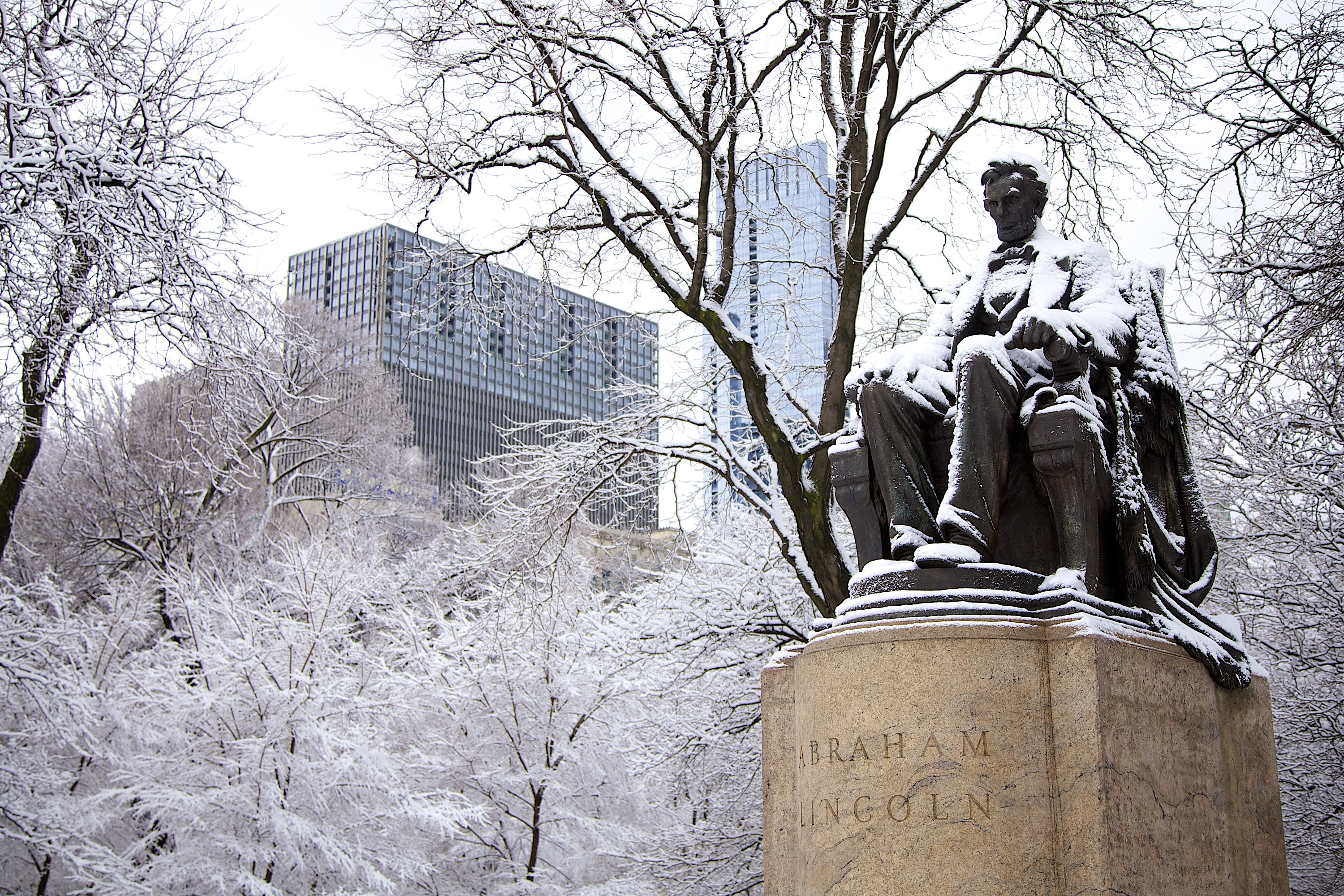 A statue of Abraham Lincoln sits under a late season blanket of snow on Chicago's lakefront and Millennium Park. DePaul experts are available to discuss the 16th president’s depiction in photography and art, and his relevance in modern times. (DePaul University/Jeff Carrion)CHICAGO – To mark Abraham Lincoln’s birthday Feb. 12 – he was born in
1809 in Kentucky – DePaul University experts are available to discuss the 16th
president’s depiction in photography and art, and his relevance in modern
times.
A statue of Abraham Lincoln sits under a late season blanket of snow on Chicago's lakefront and Millennium Park. DePaul experts are available to discuss the 16th president’s depiction in photography and art, and his relevance in modern times. (DePaul University/Jeff Carrion)CHICAGO – To mark Abraham Lincoln’s birthday Feb. 12 – he was born in
1809 in Kentucky – DePaul University experts are available to discuss the 16th
president’s depiction in photography and art, and his relevance in modern
times.
Available experts include:
Mark Pohlad, Associate Professor
of History of Art and Architecture, College of Liberal Arts and Social
Sciences. Pohlad is an expert on Lincoln in American art and culture.
“Lincoln was the first extensively photographed president, though not the first
to be photographed,” said Pohlad. “He understood that people needed to see his
likeness to be elected. Thus, he was the first president to use the medium of
photography – it was new; he was 30 years old when it was invented – in a very
modern way. Because the American photographer Mathew Brady took a famous early
photo of him, Lincoln liked to say, ‘Mathew Brady and the Cooper Union Speech
put me in the White House.’ The last photograph Lincoln had taken in Chicago –
he loved this city and often had his picture taken on Lake Street where all the
photography studios were – is the first to show him with his new presidential
beard,” he added.
“The first professional artist in Chicago, Leonard W. Volk, made some
of the earliest sculptures of him. Lincoln visited Volk's Loop studio one day
where Volk made a plaster cast of his face. Chicago has some of the best
Lincoln sculptures in the country, including Augustus Saint-Gaudens' Standing
Lincoln (1887), behind the Chicago History Museum,” Pohlad said. “That one was
actually unveiled by Lincoln's grandson, the last direct male descendent.
Another is the sculpture of Lincoln as a young lawyer at the corner of Lawrence
and Western avenues in the Lincoln Square neighborhood.” Pohlad can be reached
at 773-383-5941 or mpohlad@depaul.edu.
Larry Bennett, Professor of
Political Science, College of Liberal Arts and Social Sciences. Bennett is
an expert on urban politics and public policy, Chicago political and urban
development issues, gentrification, and political science. He can speak on
Lincoln’s relevance in today’s politics. “Abraham Lincoln’s best attributes
should always be relevant, especially for political leaders. He had a respect
for language that contemporary politicians could learn a lot from. He was a
political leader who attempted to communicate in a way that was inspiring. He
was pragmatic, patient and willing to make adjustments based on experience. His
style of leadership motivated people, and he was able to communicate that
principles motivated his actions,” Bennett said. “He attached his practical
actions to a moral universe that was justifiable and made sense to people.”
Bennett can be reached at 773-325-1973 or lbennett@depaul.edu.
Margaret Storey, Professor of
History, College of Liberal Arts and Social Sciences. Storey is an expert
on American history and the American South, including slavery, Civil War, Reconstruction,
and segregation. She can speak on Lincoln’s relevance in today’s society. “I
think that Lincoln is one of the most admired presidents in large part because
he is seen as having preserved the Union and ended slavery through the
Emancipation Proclamation and the 13th Amendment during the Civil War,” said
Storey. “He was also one of our most eloquent presidents – the first and second
inaugural addresses are among the greatest speeches in American letters – while
at the same time being an easy, funny colloquial speaker whose words are
accessible to everyday people,” she added.
“At the same time, my sense from teaching the Civil War for many years
is that there is still a very deep-seated notion that Lincoln came into office
aiming to end slavery in the South. This was not the case, but many people have
a strong desire to remember his position on slavery and race in a way that
brings him into alignment with modern values,” said Storey. “However, this
position doesn’t help us understand Lincoln, nor does it help us understand the
limits of the historical changes that the Civil War brought. Modern historians
instead point to the white supremacist world in which Lincoln existed, a world
in which he could oppose slavery on moral grounds, yet have no argument with
racist hierarchies in American society and see no imperative to create civil
equality for African-Americans, even after slavery ended. The consequences of
that racially-defined view of civil liberty – of who was an American with full
civil rights and who was not – are still being felt today,” she added.
“Personally, I admire him most for his willingness to stand for
re-election in the midst of a terrible Civil War, running against a popular
general who had a large pro-peace following. Other men might well have declared
martial law, or attempted to subvert the normal political processes in other
ways,” Storey said. “That he didn’t was a real sign of his commitment to the
integrity of the Union’s republican form of government.” Storey can be reached
at 773-325-7482 or mstorey@depaul.edu.
###
Media Contact:
Russell Dorn
rdorn@depaul.edu
312-362-7128